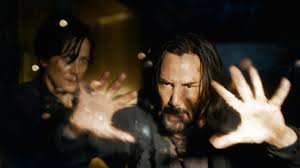“The Matrix Resurrections” is a bold and unexpected installment in the iconic franchise. Directed by Lana Wachowski, the film takes a daring approach that is both a critique and a self-referential commentary on Hollywood’s franchise culture. It’s a unique form of cinematic protest that might not be immediately apparent to all viewers.
The movie can be seen as a deliberate act of franchise sabotage, a way for the Wachowski to prevent Warner Brothers from exploiting the series in the same manner Disney has with the “Star Wars” saga. The film assumes the audience are “sheeple,” a term it uses to describe those who blindly consume media without questioning it. However, it turns this criticism inward, suggesting that Warner Brothers is equally guilty of such cynicism.
In terms of plot and execution, “The Matrix Resurrections” is intentionally terrible. This realization is key to understanding the film’s genius. Neo, portrayed by Keanu Reeves, serves as a surrogate for Lana Wachowski, embodying her struggle against being forced into producing another sequel.
One standout aspect is the film’s soundtrack, particularly the inclusion of Jefferson Airplane’s “White Rabbit.” This song acts as a metaphor for the film’s deeper message, mocking Warner Brothers’ financial motivations. The juxtaposition of the song’s lyrics with Neo’s refusal to engage in the superficial aspects of the film industry highlights the absurdity of using medication to normalize despair, contrasting with the symbolic red pill that represents the continuation of the franchise.
The film shifts from the metaphysical themes of the original trilogy to a stark commentary on the parasitic nature of Hollywood. Neo’s indifferent demeanor, coupled with his limited powers, serves as a protest against the industry’s exploitative tendencies. The film ends with a cliched note of eternal love and happiness, subtly mocking Hollywood’s typical formula, reminiscent of the ending struggle in Terry Gilliam’s “Brazil.”
“The Matrix Resurrections” stands out for its self-destructive, self-referential plot and its nonsensical dialogue, which only makes sense when viewed as a parody of Warner Brothers’ contractual demands. For the intended audience, the “sheeple,” much of the film’s subtext will likely go over their heads.
Neo’s symbolic confinement, where he can see freedom but remains bound by contractual obligations, underscores the film’s critique of Hollywood’s franchise mentality. He could easily escape but chooses to stay and fight against the machine—here, the true machine is Hollywood itself.
In conclusion, “The Matrix Resurrections” is a masterclass in subversive film-making, using its narrative and structure to deliver a powerful critique of the industry. It’s a film that is both infuriating and ingenious, destined to be misunderstood by many but appreciated by those who see the layers of its protest.

![]()





